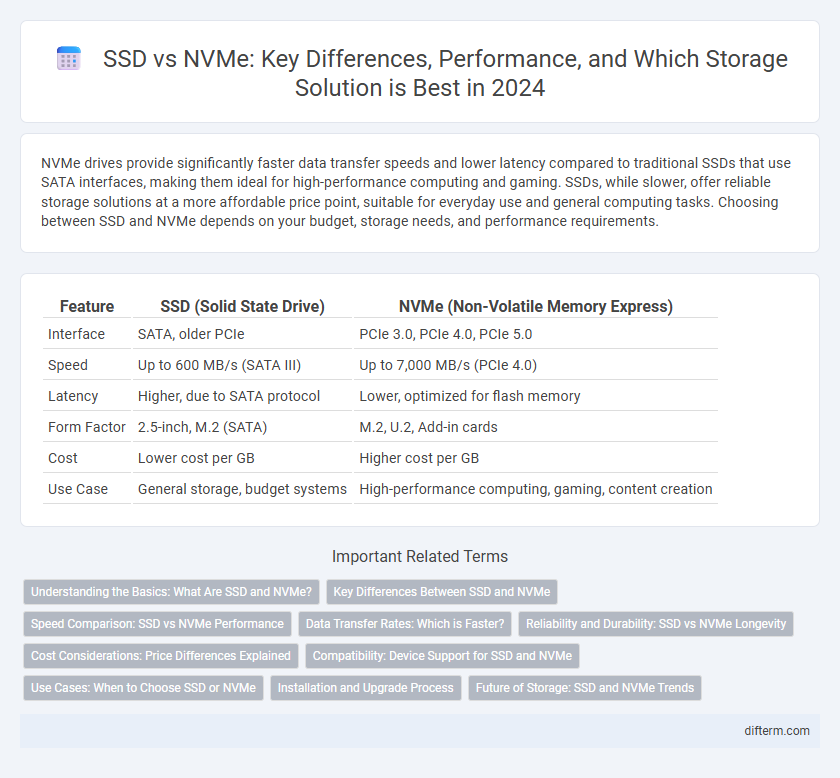NVMe drives provide significantly faster data transfer speeds and lower latency compared to traditional SSDs that use SATA interfaces, making them ideal for high-performance computing and gaming. SSDs, while slower, offer reliable storage solutions at a more affordable price point, suitable for everyday use and general computing tasks. Choosing between SSD and NVMe depends on your budget, storage needs, and performance requirements.
Table of Comparison
| Feature | SSD (Solid State Drive) | NVMe (Non-Volatile Memory Express) |
|---|---|---|
| Interface | SATA, older PCIe | PCIe 3.0, PCIe 4.0, PCIe 5.0 |
| Speed | Up to 600 MB/s (SATA III) | Up to 7,000 MB/s (PCIe 4.0) |
| Latency | Higher, due to SATA protocol | Lower, optimized for flash memory |
| Form Factor | 2.5-inch, M.2 (SATA) | M.2, U.2, Add-in cards |
| Cost | Lower cost per GB | Higher cost per GB |
| Use Case | General storage, budget systems | High-performance computing, gaming, content creation |
Understanding the Basics: What Are SSD and NVMe?
SSD (Solid State Drive) is a storage device that uses flash memory to store data, offering faster access speeds and greater durability compared to traditional hard drives. NVMe (Non-Volatile Memory Express) is a protocol specifically designed to optimize the performance of SSDs by reducing latency and increasing input/output operations per second (IOPS) through direct communication with the CPU via the PCIe interface. Understanding the distinction between SSDs as hardware and NVMe as a communication protocol is crucial for evaluating performance differences in modern storage solutions.
Key Differences Between SSD and NVMe
SSD (Solid State Drive) uses NAND-based flash memory for data storage, offering faster read/write speeds compared to traditional HDDs, while NVMe (Non-Volatile Memory Express) is a communication protocol that significantly enhances data transfer speeds by leveraging PCIe interfaces. NVMe drives provide lower latency and higher IOPS (Input/Output Operations Per Second) than SATA-based SSDs, resulting in superior performance for gaming, video editing, and large data processing tasks. The key differences lie in interface speed, data transfer efficiency, and protocol design, making NVMe drives the preferred choice for high-performance storage solutions.
Speed Comparison: SSD vs NVMe Performance
NVMe drives deliver significantly faster read and write speeds compared to traditional SATA SSDs due to their direct communication with the CPU via the PCIe interface. While SATA SSDs typically reach maximum speeds of around 600 MB/s, NVMe SSDs can exceed 3,500 MB/s, drastically improving data transfer rates and reducing latency. This speed advantage makes NVMe the preferred choice for high-performance computing tasks and gaming applications requiring rapid data access.
Data Transfer Rates: Which is Faster?
NVMe SSDs deliver significantly faster data transfer rates compared to traditional SATA SSDs due to their direct PCIe interface, enabling speeds up to 7,000 MB/s versus SATA's 600 MB/s limit. NVMe technology reduces latency and increases bandwidth by leveraging multiple parallel data lanes, optimizing performance for high-demand applications such as gaming, video editing, and data centers. This substantial speed advantage makes NVMe SSDs the preferred choice for users seeking ultra-fast data access and efficient large file transfers.
Reliability and Durability: SSD vs NVMe Longevity
NVMe drives typically offer higher reliability and durability compared to traditional SATA SSDs due to advanced error correction algorithms and superior thermal management. The use of PCIe interfaces in NVMe SSDs ensures faster data transfers with less wear on the memory cells, enhancing overall lifespan. Enterprise-grade NVMe SSDs can achieve endurance ratings of up to 10 DWPD (Drive Writes Per Day), significantly surpassing standard SATA SSD durability metrics.
Cost Considerations: Price Differences Explained
NVMe SSDs generally come at a higher price point compared to traditional SATA SSDs due to faster transfer speeds and advanced technology. The cost difference is influenced by factors such as controller complexity, NAND flash type, and performance capabilities. Budget-conscious buyers often opt for SATA SSDs, which offer reliable storage at a lower price, while NVMe drives provide superior speed and efficiency for higher investments.
Compatibility: Device Support for SSD and NVMe
NVMe drives utilize the PCIe interface, offering faster data transfer rates but requiring motherboard support for PCIe NVMe protocols, making them compatible primarily with newer devices and laptops. Traditional SATA SSDs connect via the SATA interface, ensuring broader compatibility with older systems and most desktops. Choosing between SSD and NVMe depends significantly on device compatibility, as legacy hardware may not support NVMe drives without firmware updates or BIOS support.
Use Cases: When to Choose SSD or NVMe
Choose SSDs for general computing tasks like boot drives and daily file storage where cost-effectiveness and reliable speed matter. Opt for NVMe drives in high-performance scenarios such as gaming, video editing, and large data transfers that demand ultra-fast read/write speeds and low latency. Enterprises benefit from NVMe solutions in data centers and server environments to maximize I/O operations and minimize response times.
Installation and Upgrade Process
Installing an NVMe drive typically requires an M.2 slot on the motherboard, enabling direct PCIe connection for faster data transfer compared to SATA SSDs, which use traditional SATA ports and cables. Upgrading to NVMe involves verifying motherboard compatibility and may necessitate BIOS updates, while SATA SSD installation is more universally supported across older systems. The streamlined installation and enhanced performance of NVMe drives make them a preferred choice for users seeking efficient storage upgrades.
Future of Storage: SSD and NVMe Trends
NVMe technology is revolutionizing storage with its high-speed PCIe interface, enabling significantly faster data transfer rates compared to traditional SATA SSDs. The future of storage is leaning towards NVMe drives due to their lower latency, higher IOPS, and enhanced scalability for data-intensive applications like AI and cloud computing. Emerging trends include increased adoption of NVMe over Fabrics (NVMe-oF) to extend performance benefits across networked environments, driving innovations in enterprise and consumer storage solutions.
SSD vs NVMe Infographic

 difterm.com
difterm.com